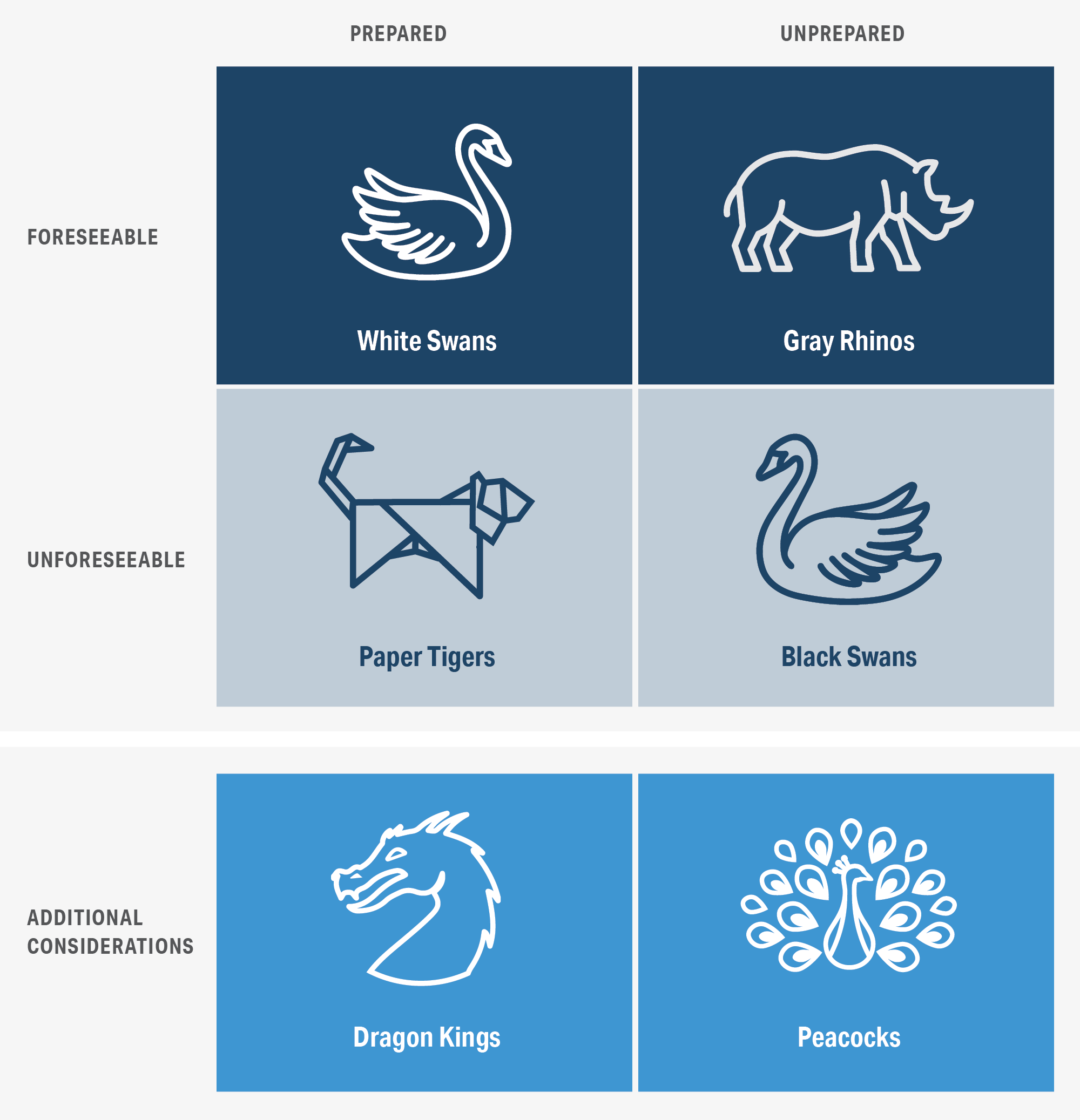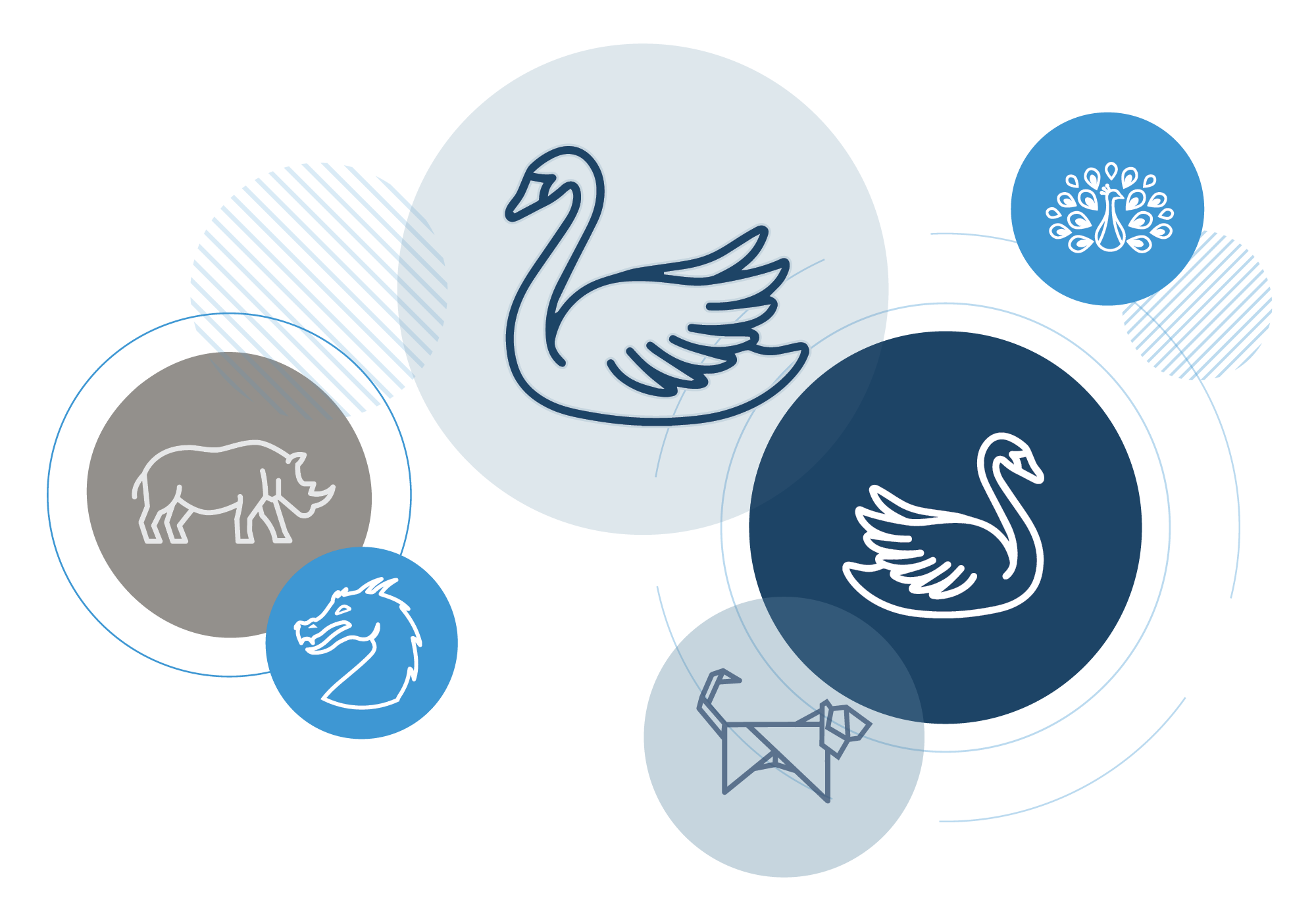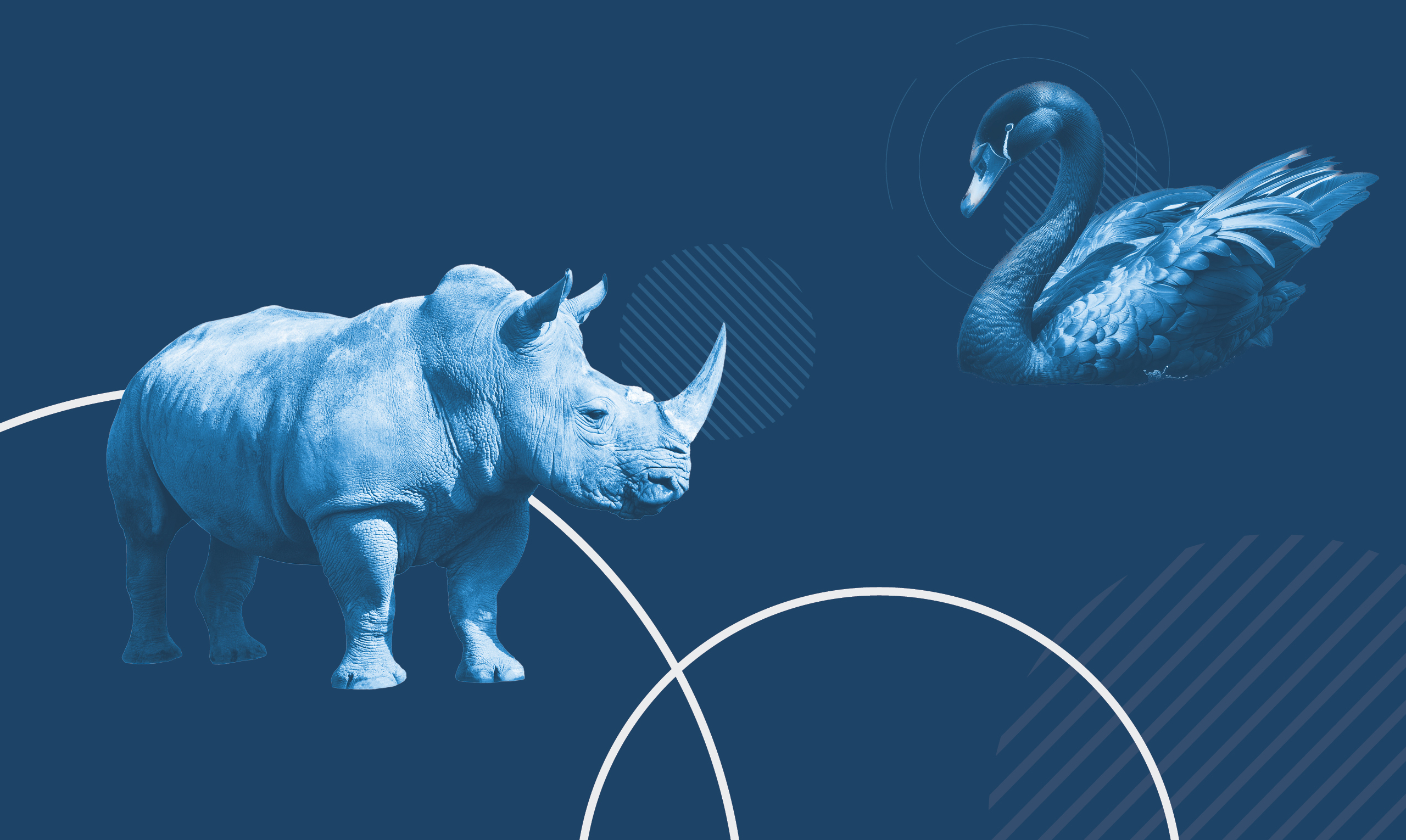- Table of Contents
- Introduction
- Making Sense of Chaos Factors
- Creatures of Chaos
- Planning for Resilience
- Leaning into Uncertainty Together
- Download the Report
Introduction
The 2020 presidential election happened amid a pandemic and racial justice protests, and it was followed by an insurrection. What can we expect in 2024?
Political observers, journalists, and others have begun raising questions about how different events could unleash uncertainty into the election year. Here are some of the things they’re thinking about:
- What if a candidate, party, or segment of the public rejects the legitimacy of an election related court ruling? How likely is it that the losing side will accept the outcome, that voters will acknowledge the winner as legitimate, and that results will be accepted peacefully?
- How will our democratic system respond to multiple criminal indictments against one of the party nominees for president? What are the implications of legal proceedings coinciding with the campaign? What would a guilty verdict mean?
- What happens if a campaign of either major party candidate is suspended? How would the timing of this affect the election?
- What if a third-party candidate garnered a significant share of the vote? Could this undercut acceptance of the result?
- What if acts of domestic terrorism and violent threats disrupt campaigning and public events? If disillusionment and frustration with our democracy turn into widespread political violence or domestic terrorism, how will we address it?
- What could happen if a new pandemic or regional climate disaster occurred on or near election day? How would the public respond to a state of emergency coinciding with voting or counting the vote?
- How disruptive could AI-enabled misinformation campaigns get? How might a campaign use AI audio or video? How might they target particular communities? Could they change the makeup of particular coalitions?
- How will our election system weather the unprecedented turnover of seasoned election administrators across the country? What could happen with a wave of new administrators?
- Could interventions or geopolitical events driven by foreign powers reshape political coalitions? How might the pro-democracy community fracture as a result of external events? How will the actions of foreign actors using social media platforms and artificial intelligence tools shape the spread of misinformation?
At Democracy Fund, we refer to these unpredictable, uncertainty-causing events as “chaos factors.”
Feeling overwhelmed? These and other chaos factors could make even the most seasoned observer throw their hands up in frustration. We are facing serious threats that — individually or in combination — could push our democracy to the brink. If those of us in the pro-democracy field are going to engage efficiently and effectively, we need a way to think about the range of variables we face.
Chaos factor: an event that, if it occurs, would create huge uncertainty in the system.
Making Sense of Chaos Factors
Conventional wisdom tells us to rank threats by how likely they are to happen and how big the impact could be. A highly likely, high-impact threat is something to pay close attention to, while an unlikely or low-impact threat is not. But the world is not that simple.
The challenge we’re dealing with in 2024 is just how much uncertainty there is. While we are already aware of a long list of chaos factors, there are likely more that we haven’t imagined. Many of the chaos factors are unprecedented, and we just don’t know what impact they might have. We can try to determine which are more likely, but we risk getting it wrong. In other words, there is a significant risk of focusing our attention and resources on threats that could be inconsequential — while ignoring those that end up mattering.
At Democracy Fund, we believe that the best way to address chaos factors isn’t to proactively anticipate and respond to specific threats, but to remain resilient in the face of any threats that might emerge. Rather than jump to “how likely is it?” about a possible threat, we can step back and also ask “is it possible to see such a thing coming?” And instead of focusing on only “how big would the impact be?” we also ask “is this something we could be prepared to respond to?”
“There is a significant risk of focusing our attention and resources on threats that could be inconsequential — while ignoring those that end up mattering.”
In 2007, Nassim Nicholas Taleb introduced the idea of the “Black Swan” into the world of foresight and strategic planning. A Black Swan is something that happens that is both unforeseeable and highly impactful. By definition, you don’t anticipate a Black Swan and you’re not prepared for it. While it may be tempting to spend our time trying to think of the one crucial event that no one else saw coming, many of the chaos factors facing our democracy in 2024 are not Black Swans. They are foreseeable, and we can prepare for them.
Since the introduction of the Black Swan, the foresight field has created a number of different terms1 for events that could or could not destabilize a system, and we’ve developed a framework using those terms to help us make sense of chaos factors. We argue that while Black Swan thinking can help us explore uncertainty, we can build overall resilience by focusing on factors we can already foresee, and which of those require additional preparation: White Swans and Gray Rhinos. Meanwhile, we can deprioritize those events we might categorize as Paper Tigers.2
Creatures of Chaos
The framework we have developed at Democracy Fund considers chaos factors as White Swans, Gray Rhinos, Paper Tigers, or Black Swans based on whether we can foresee them and/or prepare for them. Even internally, this categorization has provoked debate. For example, what may be a Gray Rhino for some can be a Black Swan for others. As Taleb has put it, “a black swan for the turkey is not a black swan for the butcher.” This debate can be useful, as it surfaces assumptions about what risks we are aware of and preparing for — and about our cognitive biases more generally. We offer the following definitions and examples for your consideration.

Foreseeable

White Swans are the opposite of Black Swans. They are events we know will happen and for which we routinely prepare. For example, flu season happens every year, and public health departments should have a clear plan of action. In the democracy field, White Swans include:
- Errors in the tabulation of votes. It is highly likely that this will happen somewhere, and election administrators generally have approaches to identify and to address it.
- Low voter turnout. This is a perennial concern, often compounded by deliberate voter suppression including intimidation and misinformation campaigns

Gray Rhinos are widely anticipated but ignored by the mainstream and largely not planned for. For example, public health experts warned about a global pandemic, but governments were largely caught off guard by rampant Covid breakouts. Likewise, the overturn of Roe v. Wade was a clear and stated goal of the conservative movement once it held a majority on the Supreme Court, yet the act still came as a shock to the public. A Gray Rhino for the U.S. election system was:
- The false claim that the 2020 election was stolen. It was not a surprise that the 2020 election results would be disputed. However, the pro-democracy field was largely unprepared for the scale and persistence of the attacks on the integrity of our election system.
Unforeseeable

Paper Tigers are vaguely defined threats that stoke fear and anxiety, but largely amount to nothing because of existing safeguards in the system. For example, relatively few of the new tech products marketed as “game changers” actually “disrupt” the system and take over meaningful market share. For U.S. elections, notable Paper Tigers are:
- Voting machine hacking. This has been advanced as a threat to our democracy, yet 2020 was “the most secure election in U.S. history.” Despite claims that some form of coordinated electoral fraud could affect the outcome of an election, instances of fraud are extremely rare, and there are numerous checks in place to maintain the integrity of the vote count.

Black Swans cannot be anticipated and cannot be prepared for. Their impact is significant. Taleb described the 9/11 terrorist attack as a Black Swan. Even though the possibility of an attack was understood, the nature and scale of the actual event was not. A Black Swan that continues to threaten our election system includes:
- The storming of the Capitol and the insurrection on Jan 6th. Protests and rallies were anticipated, but the scope and scale of the violence were not.
Two categories of events we often discuss don’t fit neatly into this framework, but they are worth keeping in the back of our minds because they can help us understand the full sweep of the impacts we might face: the Dragon King and the Peacock.

Dragon Kings are somewhat predictable but can unexpectedly bring about the collapse of the system.3 That collapse is unanticipated and catastrophic, often because we under-appreciate the scale of the event or how interdependent aspects of the system are. For example, a massive earthquake could trigger a collapse in the transport system, which then causes a failure of food distribution. In the democracy field, there may be just such a combination of events that cause governance as we know it to break down, such as:
- Election certification refusal. A critical mass of counties and/or states refuse to certify the
election results, and attempts to resolve the dispute through legal means fail. - President defies judiciary. A president refuses to abide by a court order even after an appeals process has played out.

Peacocks are totally inconsequential events that serve as a ploy for attention, often using a familiar formula or tactic. Peacocks are often distractions or cynical attempts at self-promotion.4 For example, the U.S. trucker convoy protesting federal vaccine and mask mandates was largely a manufactured controversy, because by the time it happened, the only federal requirements of this type applied to healthcare and military personnel. In terms of elections, Peacocks can include:
- Election-inflected noise. Media personalities and media channels (who may not actually have much influence over voters) spin up election-related stories or stage photo ops.
Planning for Resilience
So how does this framework help us to set priorities and develop strategies for the year ahead? At Democracy Fund, we’ve spent significant time doing strategic foresight work to help us prepare for 2024. Here are some of our recommendations.
1. Keep doing the core work
As in every election, in 2024 there is a need for poll worker training, get-out-the-vote efforts, informing the public about an election, election protection, and other “bread and butter” election work. These efforts all respond to White Swans: very real challenges that we know are real and for which we know how to prepare.
Handling White Swans may not grab the headlines the same way Black Swan efforts do. But if, for example, we lose sight of the core work of election protection, we risk letting a key part of our resilience atrophy.
We launched a multifunder campaign, All by April, because we’ve learned over many election cycles that the best way to support free, fair, and representative elections is to get money out the door early.
Many organizations are working to address Gray Rhinos. The Trusted Election Fund (TEF) is a nonpartisan pooled fund that supports efforts to prepare for and respond to high-risk threats to U.S. elections. TEF plays a critical role in helping the sector identify, communicate, plan, and support efforts to counter the range of threats we face.
This ensures that front-line election defenders have the funding they need to do the work that needs to be done.
2. Listen to the communities who can see chaos factors on the horizon
Most of the chaos factors on our list are Gray Rhinos. They are real, known risks. Are we doing enough to think through and plan for them — and identify others? We need to listen to people on the frontlines of defending our democracy and ask them what’s keeping them up at night. In particular, marginalized communities have often experienced the earliest and worst effects of our democratic system’s failures, and they are often aware of signals that indicate threats on the horizon before anyone else. As a sector, we need to build trusted relationships with people who can identify the Gray Rhinos — and take their warnings seriously.
We need to listen to the people on the frontlines of defending our democracy and ask them what’s keeping them up at night.
3. Provide early, strong support to communities most likely to be impacted.
We may not be able to foresee a Black Swan or contain its impact, but we know who is most likely to be affected — and to respond effectively in its aftermath. It’s easy to get fixated on conceiving of every imaginable threat to our democracy and think that a novel or untested approach is the best way to protect against it. But an important part of resilience is investing in the people and the ideas that we know can get the job done, and investing in them early.
Community activists, organizers, and leaders have been responsible for most of our democracy’s transformative moments, and they are a key line of defense against authoritarianism. Their movement- and power-building work has been part of our democratic system since its inception, ensuring that communities most likely to be affected by anti-democratic actors and practices are able to respond and engage. Investing in this work can help prepare our democracy for whatever comes next. The time to support movement- and power-builders is not after a crisis has occurred, but now, when they can build the critical democratic infrastructure needed to respond.
An important part of resilience is investing in the people and the ideas that we know can get the job done, and investing in them early.
4. Watch out for distractions
There will be a lot of noise in this election year: fear-mongering around Paper Tigers that our system is already built to withstand, and Peacocks designed to distract everyone from important priorities. It’s easy to get sucked into the latest headline, clickbait, or petty provocation.
We need to be disciplined about not letting our focus wander into issues and events that ultimately aren’t consequential. We also need to push back against narratives that sow distrust in our electoral system, and that seek to undermine the processes and safeguards in place to ensure that our elections are free and fair.
5. Don’t ignore the Dragon King
Catastrophic events are a possibility that’s hard to face, but we have to acknowledge the dangerous moment in which we find ourselves. We don’t want to dwell on the worst-case scenario, but ignoring it or pretending that the collapse of our democracy is simply not possible would be a grave mistake. The leadup to the 2024 election will demand our full attention, because the risks are real — and the stakes for democracy couldn’t be higher.
Leaning into Uncertainty Together
Many of us in the pro-democracy field are individually preparing for what might happen this year by doing scenario and contingency planning. This can help each of us anticipate possibilities and reduce uncertainty about how we might respond to specific events.
But what if we focused on creating resilience across our field? This would mean leaning into uncertainty together as we share insights. At first, our expanded ability to see chaos factors across the system might feel even more overwhelming. But by working together we’ll be able to have richer conversations on which chaos factors we’re seeing and how they might interact. We’ll be able to discuss how to prepare, and explore different interpretations of the longer-term impacts on our democracy.
This shared practice could create more powerful and holistic insights into how our democratic system works, and what it might take to defend and transform it into the inclusive, multiracial democracy that many of us seek. Uncertainty, after all, can be a powerful place for listening to each other, learning, and building solidarity. We can let go of the need to be right, and consider new ideas and new perspectives with curiosity and openness. We can ensure that whatever happens — whether White Swan, Gray Rhino, Paper Tiger, Black Swan, Peacock, or Dragon King — the pro-democracy sector will be prepared.

- This typology continues to be refined, reinterpreted, and adapted by many different foresight thinkers and practitioners. The definitions, examples, and framework provided here are from Democracy Fund’s internal futures and foresight practice, but we have provided citations to credit individuals who first coined the terms. [↩]
- Paper Tiger is a term that comes from the Chinese “zhǐlǎohǔ” and is not specific to the foresight field, but we have found the concept helpful to describe a certain type of event. [↩]
- Didier Sornette coined the term “Dragon King as described in the paper, Dragon-Kings, Black Swans and the Prediction of Crises.” Available at: https://papers.ssrn.com/sol3/papers.cfm?abstract_id=1596032. [↩]
- The term Peacock was popularized in the horizon scanning field by the consulting firm Global Business Network. [↩]
